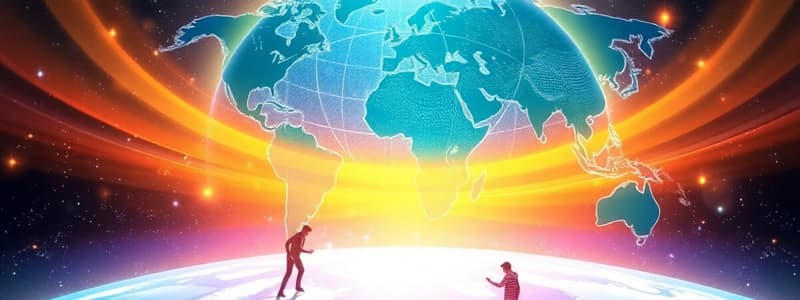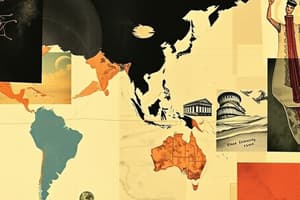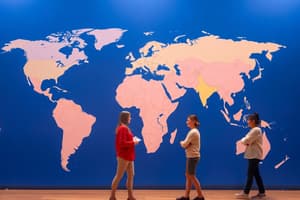Podcast
Questions and Answers
What is environmental scanning primarily used for?
What is environmental scanning primarily used for?
- To identify external opportunities and threats (correct)
- To set organizational goals
- To evaluate internal performance
- To predict future company revenues
Globalization has no effect on organizations' competitive strategies.
Globalization has no effect on organizations' competitive strategies.
False (B)
List the BRIC nations.
List the BRIC nations.
Brazil, Russia, India, China, South Africa
The _____ factors in a global environment include political/legal, economic, technological, and socio-ethical contexts.
The _____ factors in a global environment include political/legal, economic, technological, and socio-ethical contexts.
Match the following components of environmental scanning with their descriptions:
Match the following components of environmental scanning with their descriptions:
Which of the following best describes globalization?
Which of the following best describes globalization?
Environmental factors are controllable by organizations.
Environmental factors are controllable by organizations.
What is the role of regional trading alliances in global business?
What is the role of regional trading alliances in global business?
What are the two general approaches organizations can take when expanding into global markets?
What are the two general approaches organizations can take when expanding into global markets?
The political-legal context includes international trade policies and deregulation.
The political-legal context includes international trade policies and deregulation.
Name one type of legal system commonly in use.
Name one type of legal system commonly in use.
What term describes the four large emerging economies including Brazil, Russia, India, China, and South Africa?
What term describes the four large emerging economies including Brazil, Russia, India, China, and South Africa?
Globalization has primarily positive effects without any risks or threats.
Globalization has primarily positive effects without any risks or threats.
In a _______ legal system, law relies on case precedents established by an independent judiciary.
In a _______ legal system, law relies on case precedents established by an independent judiciary.
Match the following legal systems with their descriptions:
Match the following legal systems with their descriptions:
Name one of the main trading blocs mentioned in the text.
Name one of the main trading blocs mentioned in the text.
Culture can be defined as a system of values and norms that are shared among a group of people and that when taken together constitute a particular design for _____ .
Culture can be defined as a system of values and norms that are shared among a group of people and that when taken together constitute a particular design for _____ .
Which economic factors can affect business decisions in international markets?
Which economic factors can affect business decisions in international markets?
Match the following concepts to their definitions:
Match the following concepts to their definitions:
Economic policies do not impact inflation, wages, and interest rates.
Economic policies do not impact inflation, wages, and interest rates.
What aspect of the global environment is influenced by government activities?
What aspect of the global environment is influenced by government activities?
What percentage of the world's population do the BRIC countries collectively account for?
What percentage of the world's population do the BRIC countries collectively account for?
Emerging de-globalization is a rising trend in the current political discourse.
Emerging de-globalization is a rising trend in the current political discourse.
What describes the changes in the global economic order since the mid-1980s?
What describes the changes in the global economic order since the mid-1980s?
Which of the following is an example of e-business?
Which of the following is an example of e-business?
A differentiation strategy focuses on offering low-cost solutions to customers.
A differentiation strategy focuses on offering low-cost solutions to customers.
What is one way that technology affects organizations?
What is one way that technology affects organizations?
An organization must manage the _____ environment to ensure its success.
An organization must manage the _____ environment to ensure its success.
Match the competitive strategies with their definitions:
Match the competitive strategies with their definitions:
Which of the following is NOT a component of the macro global environmental influences?
Which of the following is NOT a component of the macro global environmental influences?
The social-ethical context does not influence employee behavior.
The social-ethical context does not influence employee behavior.
Name one major change in society that has affected business practices.
Name one major change in society that has affected business practices.
Flashcards
Global Business Environment
Global Business Environment
All factors outside an organization that affect it.
Globalisation
Globalisation
Deepening connections between people, groups, and organizations worldwide.
Environmental Scanning
Environmental Scanning
Identifying external opportunities & threats.
External Scanning Components
External Scanning Components
Signup and view all the flashcards
Trends (Scanning)
Trends (Scanning)
Signup and view all the flashcards
Competition (Scanning)
Competition (Scanning)
Signup and view all the flashcards
Technology (Scanning)
Technology (Scanning)
Signup and view all the flashcards
Customers (Scanning)
Customers (Scanning)
Signup and view all the flashcards
Global Business Expansion
Global Business Expansion
Signup and view all the flashcards
Proactive Expansion
Proactive Expansion
Signup and view all the flashcards
Reactive Expansion
Reactive Expansion
Signup and view all the flashcards
Political-Legal Context
Political-Legal Context
Signup and view all the flashcards
Common Law System
Common Law System
Signup and view all the flashcards
Civil Law System
Civil Law System
Signup and view all the flashcards
Theocratic Law System
Theocratic Law System
Signup and view all the flashcards
Economic Context
Economic Context
Signup and view all the flashcards
E-business definition
E-business definition
Signup and view all the flashcards
Cost Leadership Strategy
Cost Leadership Strategy
Signup and view all the flashcards
Differentiation Strategy
Differentiation Strategy
Signup and view all the flashcards
Focus Strategy
Focus Strategy
Signup and view all the flashcards
Global Macro Environment
Global Macro Environment
Signup and view all the flashcards
Competitive Environment
Competitive Environment
Signup and view all the flashcards
Open System
Open System
Signup and view all the flashcards
Contingent Influences
Contingent Influences
Signup and view all the flashcards
Regional Trading Alliances
Regional Trading Alliances
Signup and view all the flashcards
BRICS Economies
BRICS Economies
Signup and view all the flashcards
Cultural Differences
Cultural Differences
Signup and view all the flashcards
Free Market Capitalism
Free Market Capitalism
Signup and view all the flashcards
Global Marketplace
Global Marketplace
Signup and view all the flashcards
Emerging Economies
Emerging Economies
Signup and view all the flashcards
Trading Blocs
Trading Blocs
Signup and view all the flashcards
Study Notes
MG4031 Management Principles - The Global Business Environment
- The course covers the global business environment, specifically focusing on the reading material from Chapter 3 of "Modern Management" (pages 81-123).
- Learning objectives include understanding terms like global external business environment and globalization, their impact on organizations, and global trade. Also, understanding the roles of regional trading alliances in competition. Appreciating shifting global economic power, particularly regarding BRIC nations (Brazil, Russia, India, China, & South Africa), as well as factors in the macro environment (political/legal, economic, technological, and socio-ethical contexts). Furthermore, modelling the immediate competitive environment (competitors, suppliers, customers, new entrants, substitute products).
- The global business environment is defined as all factors affecting an organisation that lie outside its immediate control. It is not an excuse for poor performance; environmental scanning, to anticipate and manage these external influences, is vital for survival.
- Environmental scanning is a systematic way of monitoring and interpreting data to identify potential opportunities and threats. It's a critical process for organisations impacting future decisions.
- Key components of external scanning include trends (market and industry), competition (competitive advantages, weaknesses), technology (impact on efficiency), customers (changing customer base), and labour supply (access to talent).
- Globalization is the increasing and deepening interactions and connections between individuals, groups, and organizations across the world. It's a shift towards a single global marketplace driven by the spread of free market capitalism. Globalisation has led to significant changes in the global economic order.
- Globalisation presents both substantial opportunities and challenges. The world economy has changed dramatically since the end of the Cold War, with significant pressures on natural resources, climate, and traditional industries and livelihoods. Increased political polarisation, rising populism, nationalism, conflict and debates about emerging de-globalisation are also significant trends.
- Regional trading alliances are significant global influences, including the enlarged European Union, the North American Free Trade Agreement (NAFTA), Mercosur, and the Association of Southeast Asian Nations (ASEAN). Other trading groups, such as CARICOM and the African Continental Free Trade Agreement (AfCFTA) exist across the world.
- BRIC/BRICS economies (Brazil, Russia, India, China, & South Africa) are emerging large economies with significant demographic and economic potential. They are collectively impactful, comprising significant populations (over 40% of the world's population), considerable land area across three continents, and account for a substantial part of global GDP (over 25%).
- Culture, a system of shared values and norms, is vital in the global business environment, greatly shaping how things are done and viewed across the world.
- Understanding cultural differences is essential for successful international expansion. Methods of classifying cultural differences are important.
- The decisions to enter the global business environment, when, and how are often impacted by a careful consideration of the different aspects of the macro and competitive environments. This includes deciding where to expand, when to expand, and the specific entry mode to be used.
- The competitive environment includes forces such as the threat of new entrants, the bargaining power of buyers, the bargaining power of suppliers, the threat of substitutes, and the intensity of rivalry among competing firms, these can be analyzed using Porter's Five Forces.
- Companies often strive to achieve competitive advantage through cost leadership, differentiation, or a focus strategy.
- Understanding legal systems (common law, civil law, theocratic law) and economic conditions is important for global business success. Technological advancements, and social and ethical considerations must also be accounted for.
Studying That Suits You
Use AI to generate personalized quizzes and flashcards to suit your learning preferences.



